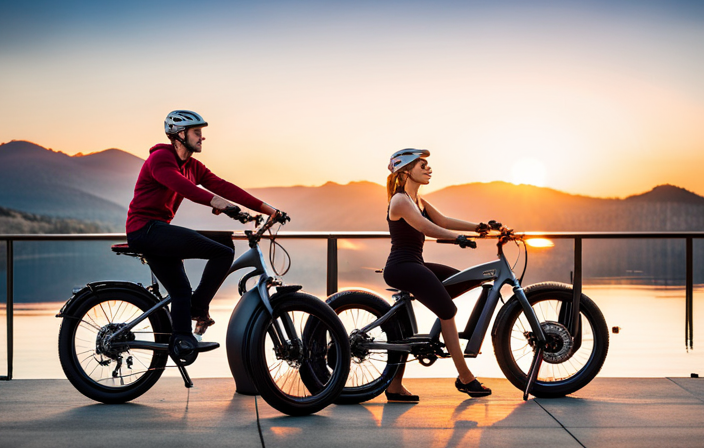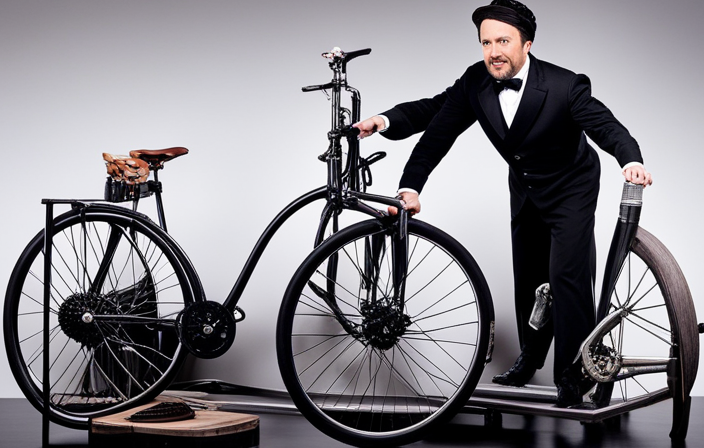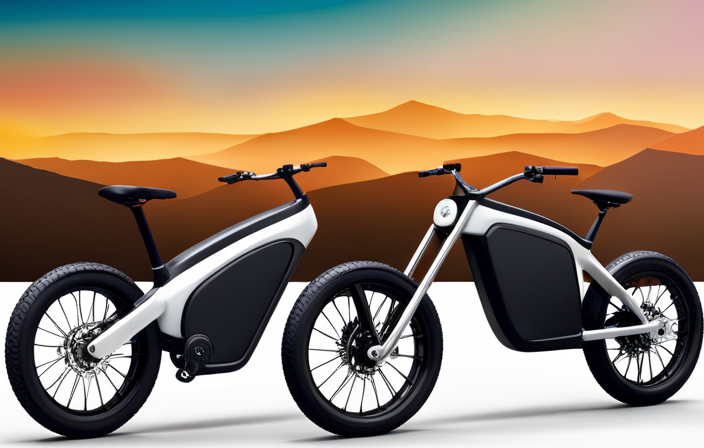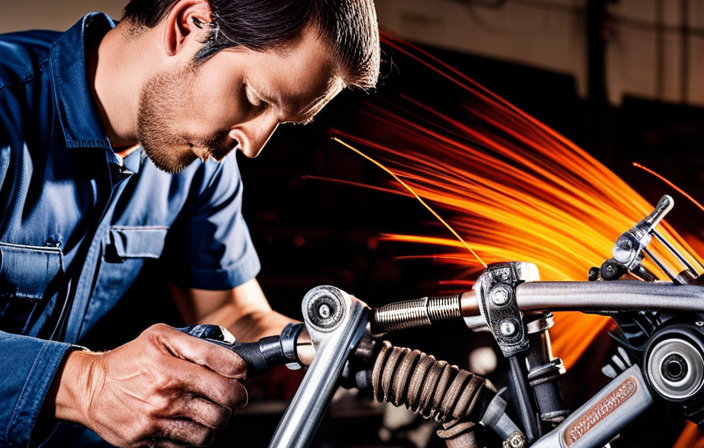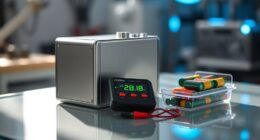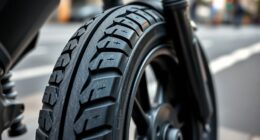Are you looking to purchase an electric bike? If yes, you may be asking yourself, ‘Which motor is the best?’ With numerous choices to choose from, it can be challenging to make the right decision.
But fear not, as this article is here to guide you through the maze of motor choices. From hub motors to mid-drive motors, brushed motors to brushless motors, we will analyze the pros and cons of each type, helping you find the perfect motor for your riding style and needs.
Key Takeaways
- Consider motor compatibility and battery capacity when selecting components for your electric bike.
- Pedal assist sensors offer advantages over throttle control, such as efficient power distribution and extended battery life.
- Regenerative braking harnesses energy generated while braking to improve the efficiency of your e-bike.
- Motor weight and placement should be balanced for optimal performance and handling.
Hub Motors: A Popular Choice for Electric Bikes
Hub motors are a popular choice for electric bikes because they are compact and provide a smooth ride. These motors are typically located in the center of the wheel, allowing for easy installation and maintenance. When it comes to power and speed, hub motors excel, providing quick acceleration and the ability to reach high speeds. Additionally, these motors are known for their durability and longevity, thanks to their simple design and fewer moving parts. This means less maintenance and a longer lifespan for your electric bike.
Now, let’s transition into the next section about ‘mid-drive motors: power and efficiency combined’. These motors offer a different approach to electric bike propulsion, focusing on utilizing the power and efficiency of a central motor located near the bike’s bottom bracket.
Mid-Drive Motors: Power and Efficiency Combined
For optimal power and efficiency combined in your electric bike, you should consider using a mid-drive motor. Unlike hub motors, which are positioned in the wheel, mid-drive motors are positioned at the crankshaft, near the pedals. This motor positioning allows for better weight distribution and a lower center of gravity, resulting in improved handling and stability.
When it comes to power delivery, mid-drive motors are designed to optimize performance. By directly transferring power to the drivetrain, these motors provide a more natural and efficient riding experience. Additionally, mid-drive motors typically feature multiple gears, allowing riders to adjust their power output according to the terrain or desired speed.
Another advantage of mid-drive motors is their superior cooling capability. Being positioned in the center of the bike, these motors benefit from the airflow generated while riding, preventing overheating and ensuring reliable operation even during long rides or steep climbs.
By incorporating a mid-drive motor into your electric bike, you can enjoy the perfect balance between power and efficiency. Now, let’s move on to the next section about direct drive motors: smooth and silent performance.
Direct Drive Motors: Smooth and Silent Performance
When it comes to direct drive motors, you’ll experience smooth and silent performance. These motors are known for their efficiency and low power consumption.
Direct drive motors eliminate the need for gears, resulting in a more straightforward and direct transfer of power from the motor to the wheels. This efficiency translates to a longer battery life and less energy wastage.
Additionally, direct drive motors have excellent heat dissipation and cooling mechanisms, ensuring optimal performance even under heavy load. The lack of gears also means fewer moving parts, reducing the chances of mechanical failure and increasing the overall reliability of the motor.
With their combination of efficiency, power, and reliability, direct drive motors are a top choice for those seeking a smooth and quiet riding experience.
Moving on to geared motors, which enhance torque and efficiency…
Geared Motors: Enhancing Torque and Efficiency
To enhance torque and efficiency, you’ll want to consider using geared motors. Geared motors offer several advantages over direct drive motors.
Firstly, they provide increased torque, which allows for better acceleration and climbing capabilities. Additionally, geared motors are more efficient, as they can operate at a higher RPM range, resulting in improved overall performance.
Another benefit of geared motors is their compact size and lightweight design, making them suitable for electric bikes where space is limited. However, it’s important to note that geared motors do have some disadvantages. They tend to produce more noise compared to direct drive motors, and the gears may require periodic maintenance or replacement.
These factors should be taken into consideration when deciding on the best motor for your electric bike.
Transitioning into the subsequent section about brushed motors vs. brushless motors, it’s important to understand the pros and cons of each option.
Brushed Motors vs. Brushless Motors: Which is Better?
If you’re deciding between brushed and brushless motors, it’s important to understand the differences and advantages of each option.
Brushless motors offer higher power and efficiency compared to brushed motors. This is because brushless motors use electronic commutation instead of brushes, resulting in less friction and wear. They also have a higher power-to-weight ratio, making them ideal for electric bikes.
However, brushless motors tend to be more expensive than brushed motors. On the other hand, brushed motors are more budget-friendly but may not provide the same level of power and efficiency.
When choosing between the two, consider your budget and the specific needs of your electric bike.
Now, let’s move on to the next section about power output: understanding wattage and performance.
Power Output: Understanding Wattage and Performance
Now that we’ve discussed the differences between brushed and brushless motors, let’s move on to understanding the relationship between power output and wattage when it comes to electric bike motors.
When it comes to electric bikes, wattage plays a crucial role in determining the speed and performance of the motor. Higher wattage motors generally provide more power and speed, allowing you to reach higher top speeds and traverse longer distances. However, it’s important to consider efficiency as well.
A motor with higher wattage may consume more energy, resulting in decreased battery life. Therefore, finding the right balance between wattage and efficiency is key. By understanding the relationship between wattage, speed, efficiency, and power output, you can make an informed decision when choosing the best motor for your electric bike.
This brings us to the next important aspect: torque, the key to climbing hills with ease.
Torque: The Key to Climbing Hills with Ease
Torque is essential for effortlessly ascending hills. When it comes to electric bike motors, torque is a crucial factor that determines how well your bike can tackle steep inclines. Here are four reasons why torque is key for conquering hills with ease:
-
Increased motor efficiency: A motor with higher torque can deliver power more efficiently, allowing you to maintain a steady speed while climbing uphill.
-
Improved power delivery: Torque ensures a smooth power delivery, providing you with the necessary force to overcome resistance and conquer challenging terrains.
-
Enhanced climbing capability: With higher torque, your electric bike can climb hills at a faster pace, making your rides more enjoyable and efficient.
-
Reduced strain on the motor: A motor with sufficient torque won’t be strained when tackling hills, leading to less wear and tear in the long run.
Considering motor efficiency and power delivery are important factors for hill climbing, it’s time to explore another crucial aspect: battery compatibility. Matching the motor to the battery ensures optimal performance and longevity.
Battery Compatibility: Matching the Motor to the Battery
Matching the motor to the battery is crucial for ensuring optimal performance and longevity of your electric bike. Motor compatibility is essential because different motors require different battery capacities to function efficiently.
It is important to choose a battery that can provide enough power to meet the demands of your motor. If the battery capacity is too low, it may not be able to deliver enough current to the motor, resulting in reduced performance and a shorter lifespan for both the motor and the battery.
On the other hand, if the battery capacity is too high, it can add unnecessary weight to your electric bike, making it less maneuverable and efficient. Therefore, it is important to carefully consider the motor compatibility and battery capacity when selecting components for your electric bike. This will ensure that your bike functions optimally and lasts for a long time.
As we move on to the next section about pedal assist sensors, you will learn how these sensors can enhance your riding experience.
Pedal Assist Sensors: Enhancing Your Riding Experience
To enhance your riding experience, you’ll love how pedal assist sensors make your electric bike feel like an effortless extension of your own power. Pedal assist technology offers several advantages over throttle control, making it the preferred choice for many electric bike riders. Here’s why:
-
Efficient Power Distribution: Pedal assist sensors detect your pedaling motion and provide proportional assistance, ensuring a smooth and natural ride.
-
Extended Battery Life: Because pedal assist relies on your input, it maximizes the efficiency of your battery, allowing you to go further on a single charge.
-
Improved Control: Pedal assist technology allows for precise control over the level of assistance, giving you the freedom to choose how much power you want.
-
Health and Fitness Benefits: With pedal assist, you can still enjoy the health benefits of cycling while getting a little extra help when needed.
With these benefits in mind, it’s clear why pedal assist technology is the way to go.
Now, let’s explore how regenerative braking can further enhance the efficiency of your electric bike.
Regenerative Braking: Harnessing Energy for Efficiency
Regenerative braking is a feature that harnesses the energy generated while braking to improve the efficiency of your e-bike. By converting kinetic energy into electrical energy, regenerative braking helps to optimize energy efficiency, allowing you to go further on a single charge. This innovative technology not only benefits the environment but also provides a smoother riding experience.
To better understand the advantages of regenerative braking, let’s take a look at the table below:
| Benefits of Regenerative Braking |
|---|
| Increased range on a single charge |
| Extended battery life |
| Reduced energy consumption |
| Enhanced control and stability |
| Improved braking performance |
As you can see, regenerative braking offers numerous benefits, including increased range, extended battery life, and improved braking performance. By harnessing the energy that would otherwise be wasted during braking, this feature maximizes the efficiency of your e-bike.
Transitioning into the subsequent section about noise and vibration, considering comfort and ride quality, it is important to also address the impact of regenerative braking on these factors.
Noise and Vibration: Considering Comfort and Ride Quality
Transitioning into the subsequent section about noise and vibration, it’s important to consider how regenerative braking impacts the comfort and ride quality of your e-bike. When it comes to vibration reduction, the type of motor you choose plays a crucial role. Here are three key factors to consider:
-
Motor Design: Opt for a motor that is specifically designed to reduce vibration. Look for features such as balanced rotor construction and precision engineering to minimize vibrations.
-
Mounting System: The way the motor is mounted can also affect the level of vibration. Choose a bike with a robust mounting system that effectively absorbs and dampens vibrations, providing a smoother and more comfortable ride.
-
Noise Reduction: In addition to vibration, noise can also impact your riding experience. Select a motor that incorporates noise reduction technologies, such as sound-damping materials or optimized gear systems, for a quieter ride.
Considering vibration reduction and noise reduction, the next section explores the importance of motor weight and placement in balancing performance and handling.
Motor Weight and Placement: Balancing Performance and Handling
When considering the weight and placement of your e-bike’s motor, you should focus on finding a balance between performance and handling. Motor weight and placement play a crucial role in optimizing the overall riding experience. The motor power should be chosen carefully to ensure it provides enough torque and speed without compromising the handling of the bike. A heavier motor can affect the weight distribution and stability, making it harder to maneuver the bike. On the other hand, a lighter motor may not provide enough power for uphill climbs or off-road adventures. By finding the right balance, you can ensure that your electric bike offers both great performance and responsive handling.
To visually represent the importance of motor weight and placement, consider the following table:
| Motor Weight | Handling | Performance |
|---|---|---|
| Light | Poor | Low |
| Moderate | Average | Average |
| Heavy | Excellent | High |
Finding the right balance between motor weight and placement is crucial for optimizing your e-bike’s performance and handling. Next, we will delve into the importance of controller technology in fine-tuning your electric bike’s performance.
Controller Technology: Fine-Tuning Your Electric Bike’s Performance
Controller technology plays a crucial role in fine-tuning the performance of your e-bike. With advancements in controller technology, you can optimize energy consumption and customize the performance characteristics of your motor.
Motor efficiency is a key factor to consider when choosing a controller, as it determines how effectively the motor converts electrical energy into mechanical power. By selecting a controller that maximizes motor efficiency, you can enhance the range and overall efficiency of your electric bike.
Additionally, tuning motor parameters allows you to customize the performance of your e-bike to suit your specific needs and preferences. Whether you want more torque for off-road adventures or a smoother ride for urban commuting, controller technology gives you the ability to fine-tune your electric bike’s performance.
Moving forward to the next section about maintenance and durability, it’s important to choose a motor built to last, ensuring long-term reliability and enjoyment.
Maintenance and Durability: Choosing a Motor Built to Last
To ensure your e-bike lasts in the long run, it’s important to choose a motor that is built to withstand the test of time. Motor maintenance plays a crucial role in the longevity and reliability of your electric bike. Regularly inspecting and cleaning the motor can prevent issues from arising and extend its lifespan.
Additionally, choosing a motor with high-quality components and a durable construction can greatly enhance its durability. Look for motors that are designed to handle the demands of your riding style and terrain. Consider factors such as torque, power output, and heat dissipation capabilities.
By selecting a robust motor and properly maintaining it, you can enjoy years of trouble-free riding. Now, let’s delve into finding the perfect motor for your riding style and needs.
Finding the Perfect Motor for Your Riding Style and Needs
Finding the perfect motor for your riding style and needs can greatly enhance your e-bike experience. When it comes to motor power, it’s important to find the right balance between speed and range. A motor with higher power will provide faster acceleration and higher top speeds, but it may also drain the battery more quickly. On the other hand, a motor with lower power may offer longer range but could compromise on speed. It’s crucial to consider your riding habits and routes to determine the ideal power level for your motor.
Another important aspect to consider is motor cooling. Keeping your motor running smoothly is essential for its durability and overall performance. Look for motors that have effective cooling systems, such as heat sinks or fans, to prevent overheating during long rides or intense usage.
In summary, finding the perfect motor for your e-bike involves striking the right balance between motor power and range, as well as ensuring proper motor cooling to maintain optimal performance.
Frequently Asked Questions
Can I use a hub motor on a mountain bike?
Yes, you can definitely use a hub motor on a mountain bike. Using a hub motor on a mountain bike has several benefits.
Firstly, it provides a direct drive system, which means it delivers power directly to the wheel, resulting in efficient and smooth acceleration.
Additionally, hub motors are generally quieter and require less maintenance compared to mid-drive motors.
However, it’s important to note that hub motors may not offer the same level of torque and hill-climbing ability as mid-drive motors.
What is the difference between a brushed motor and a brushless motor?
A brushed motor and a brushless motor are two types of electric motors commonly used in various applications. The main difference lies in their construction and operation.
Brushed motors use brushes and a commutator to transfer electrical energy, while brushless motors use electronic controllers for energy transfer.
Brushless motors offer several advantages, such as higher efficiency, longer lifespan, and lower maintenance requirements. However, they are usually more expensive and require more complex control systems compared to brushed motors.
How does pedal assist sensor technology work?
Using a torque sensor in electric bike pedal assist systems has its pros and cons.
One interesting statistic is that torque sensors are more accurate than cadence sensors, providing a smoother and more natural riding experience.
The advantage of torque sensors is that they can measure the force you apply to the pedals, allowing the motor to provide proportional assistance.
However, this technology can drain the battery faster compared to cadence sensors, as it requires more power to operate.
Is regenerative braking available on all electric bike motors?
Regenerative braking is not available on all electric bike motors. While it offers benefits such as extending the battery range and providing a more efficient ride, it also has some drawbacks.
The main disadvantage is that regenerative braking can put strain on the battery, potentially reducing its lifespan. Additionally, the technology adds weight and complexity to the bike.
Therefore, when considering an electric bike, it’s important to weigh the pros and cons of regenerative braking and its impact on battery life.
How does motor weight affect the handling of an electric bike?
Motor weight has a significant impact on the handling of an electric bike. The heavier the motor, the more sluggish and unwieldy the bike becomes, making it harder to maneuver and control. This is especially noticeable when navigating tight turns or steep inclines.
Additionally, a heavier motor can put strain on the bike’s frame and components, potentially leading to premature wear and tear. It’s crucial to consider motor weight along with battery capacity to ensure optimal performance and handling.
Conclusion
So, which motor is the best for your electric bike? After considering the various options available, it ultimately comes down to your riding style and needs.
Hub motors are a popular choice for their simplicity and ease of maintenance.
Mid-drive motors offer a powerful and efficient performance, while direct drive motors provide a smooth and silent ride.
Geared motors enhance torque and efficiency, while the choice between brushed and brushless motors depends on your preference for durability and performance.
With careful consideration of motor weight and placement, controller technology, and maintenance and durability, you can find the perfect motor that balances performance and handling.
So, what are you waiting for? Take your electric bike to the next level and choose the motor that best suits your needs and preferences.
